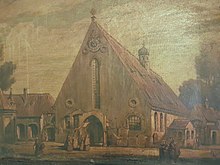Franciscan monastery (Munich)
The Franciscan monastery in Munich, consecrated from 1392 to Saint Anthony of Padua , was founded in 1284 by the Bavarian Duke Ludwig II, the Strengen and the Munich patrician family of the Sendlingers . In 1802 the monastery was dissolved. The Bavarian National Theater and the Residenz Theater are located on the former grounds of the monastery at Max-Joseph-Platz .
history
At the request of Duke Ludwig the Strict, the brothers of the Franciscan Order, founded in 1210, relocated their convent to an area north of the Old Court in 1284 . Before that, they had lived in the Angerkloster , where after 1221 the first Franciscan had settled at the Jakobuskapelle in simple circumstances ( humilis aedis , simple room).
From 1330 to 1347 the important medieval late scholastics Wilhelm von Ockham , the superior general of the order, Michael of Cesena , and Bonagratia of Bergamo worked here ; they had to face Pope John XXII. flee from Avignon and were able to live for a few years in the Munich Franciscan monastery under the protection of the Roman-German King Ludwig the Bavarian .
At the urging of Elector Maximilian I , an order reform was carried out in the convents located in Bavaria from 1620 onwards towards strict observance with stricter observance of the vow of poverty (" Franciscan Reformates "). First of all, the Munich convent was forced to observe observance on behalf of the Pope by Father Antonius a Galbiato, an Italian reformate from the Milanese Franciscan Province ; the superiors were deposed, and the brothers, who did not want to forego all income from foundations, had to leave the monastery. In March 1625, the monastery became the seat of the provincial of the newly founded Bavarian Franciscan Province of St. Antonius ( Bavaria ), which until then had been a custody of the Strasbourg Province of Provincia Argentina , also known as the "Upper German Province". The patronage of the Munich monastery was taken over for the new province.
In 1802 the monastery was secularized . The church and the still existing monastery buildings were then torn down for the construction of the National Theater , which burned down shortly afterwards twice, in 1817 and 1823, so that at that time people spoke of “a punishment from heaven”. Since 1827 the Franciscans have been at home in Munich in the St. Anna im Lehel monastery .
During the construction of the underground car park at Max-Joseph-Platz in 1963, the remaining underground remains of the Franciscan monastery and the associated cemetery were cleared away without any major scientific research.
literature
- Wilhelm Kücker : The old Franciscan monastery in Munich - building history and reconstruction. Obb. Archive Volume 86, Historic Association of Upper Bavaria, Munich 1963.
Individual evidence
- ↑ Raynald Wagner: On the history of the Bavarian Franciscan Province from 1625 to 1802. In: Bayerische Franziskanerprovinz (Hrsg.): 1625 - 2010. The Bavarian Franciscan Province. From its beginnings until today. Furth 2010, pp. 6–29, here p. 7f.
- ↑ Raynald Wagner: On the history of the Bavarian Franciscan Province from 1625 to 1802. In: Bayerische Franziskanerprovinz (Hrsg.): 1625 - 2010. The Bavarian Franciscan Province. From its beginnings until today. Furth 2010, pp. 6–29, here pp. 11–14.
- ^ Karlheinz Hemmeter: The monument to King Max I. Joseph in Munich by Christian Daniel Rauch . History of origin - contemporary art literature - on the genesis of Max-Joseph-Platz. In: Susanne Böning-Weis (Red.): King Max I. Joseph. Model and monument. On an installation by Erich Lindenberg in the Alte Münze in Munich (= workbooks of the Bavarian State Office for Monument Preservation, No. 86), Munich 1996, pp. 35–85, here p. 77.

